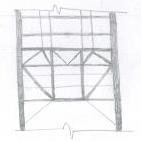-
Posts
1470 -
Joined
-
Last visited
-
Days Won
444
Reputation Activity
-
 UmarMakhzumi reacted to Badar (BAZ) in Concrete Slab Design
UmarMakhzumi reacted to Badar (BAZ) in Concrete Slab Design
The purpose of structural analysis, as Graham Powel puts it esoterically and with simplicity, "is not to get an exact simulation of behavior ..... the goal is to get demand/capacity ratios that are accurate enough for decision making". The exact analysis is not required for engineering problems, and it is not possible as well.
For most RC slab-beam systems, the slab is only required to resist gravity loads. For gravity loads, you do not need to do ELF. The coefficients method of ACI 314R-11 will do the job even with its limitations. Same is true for one-way panels; you can use coefficients in ACI 318.
For academic purposes, you can model your floor system in SAFE or can get the results for ETABS as well, as it can do design of slab as well.
In actual practice, the level of investigation and scrutiny put on a particular structural member depends on the importance of the structural member in overall structural system.
In your case, RC floor is the structural member with most load paths. It can transfer loads in ways unimaginable by most structural engineers. It does not warrant a detailed scrutiny unless it is acting as s transfer member at podium levels of a tall building.
-
 UmarMakhzumi got a reaction from Waqar Saleem in Bore holes
UmarMakhzumi got a reaction from Waqar Saleem in Bore holes
This is a very good question. Generally speaking, Areas of interest are highlighted by structural engineer but number and location of bore holes is suggested by Geotechnical Engineering keeping structural in the loop. Number of bore holes depend upon consistency between different boreholes (once they drill boreholes and if the data is not consistent, then they might need to drill more), type of structure (some structures are very sensitive to settlement, like Large LNG Tanks) so a lot of bore holes would be done for a tank foundation than for other equipment foundation etc. Experience and engineering judgement also play a part. To sum up, Site variability in geotech info and Structural Sensitivity to geotech info are the major factors.
Thanks.
-
 UmarMakhzumi reacted to Waqar Saleem in STRUCURAL PLANNING / STRUCTURAL SCHEME
UmarMakhzumi reacted to Waqar Saleem in STRUCURAL PLANNING / STRUCTURAL SCHEME
Salam,
Adding my cent to the BAZ's response, intuition: your basic understanding, visualization, imagination, observation: observe different structural system around you, man-made and natural, observe how they sustain different kind of loads successfully, observe how seniors are tackling different problems, observe and investigate failures of structural members or structures, imagine how structure will fail reading: read about structural materials, understand their properties and behaviors, weaknesses and benefits, understand their mechanics under loads, read structural analysis and structural design books talking: talking or thinking aloud, discussing with colleagues and fellow structural engineers, this builds confidence and clarity in concepts, if you can not talk about a concept its understanding is unclear yet.
@Badar (BAZ) please correct if anything added wrong.
Regards
-
 UmarMakhzumi reacted to Badar (BAZ) in STRUCURAL PLANNING / STRUCTURAL SCHEME
UmarMakhzumi reacted to Badar (BAZ) in STRUCURAL PLANNING / STRUCTURAL SCHEME
Combination of following: intuition, observation, reading and talking about it.
-
 UmarMakhzumi reacted to Muhammad Hashmi in Moment resistance of Pinned/Hinged structure?
UmarMakhzumi reacted to Muhammad Hashmi in Moment resistance of Pinned/Hinged structure?
Muhammad.
Advise to consider the support condition for the foundation to be fixed to transfer the moments at the base that will also makes your super structure vertical members columns+sw's lighter.
-
 UmarMakhzumi reacted to Waqar Saleem in Moment resistance of Pinned/Hinged structure?
UmarMakhzumi reacted to Waqar Saleem in Moment resistance of Pinned/Hinged structure?
salam,
We assume it fixed where we need to transfer moments, though actual behavior is not exactly fixed its in between fixed and hinge/pin.
Regards
-
 UmarMakhzumi got a reaction from G_Farooq in Best University For MSc. Structural Engineering
UmarMakhzumi got a reaction from G_Farooq in Best University For MSc. Structural Engineering
Good luck and also it is great to have initiatives like you did.
You can also work part-time with someone to get design experience and then start expanding your services. There are a lot of engineers on this forum that you can contact and engage for peer review. A lot of firms do that.
-
 UmarMakhzumi got a reaction from Ayesha in Confined Masonry Guidelines Pakistan
UmarMakhzumi got a reaction from Ayesha in Confined Masonry Guidelines Pakistan
Dear All,
While browsing the internet, I came across the following confined masonry guidelines available free to public. They are very informative and would add value to you design practise.
Source: http://www.confinedmasonry.org
Enjoy.
Confined Masonry Earthquake Resistant Guideline .pdf
Construction-Guide-for-Low-Rise-Confined-Masonry-Buildings.pdf
Pakistan_CM-manualv3.0.3TomSchacher.pdf
Pakistan_confined-masonry-english.pdf
Pakistan_ERRA_Guideline_CM.pdf
-
 UmarMakhzumi got a reaction from Muhammad Hashmi in Best University For MSc. Structural Engineering
UmarMakhzumi got a reaction from Muhammad Hashmi in Best University For MSc. Structural Engineering
Good luck and also it is great to have initiatives like you did.
You can also work part-time with someone to get design experience and then start expanding your services. There are a lot of engineers on this forum that you can contact and engage for peer review. A lot of firms do that.
-
 UmarMakhzumi reacted to Engr. Arslan Raza in Best University For MSc. Structural Engineering
UmarMakhzumi reacted to Engr. Arslan Raza in Best University For MSc. Structural Engineering
I simply posted a question here which was ''which is best university to do MSc Structural Engineering'' and I have yet to receive an answer.
I am merely designing 3 stories houses and plazas of 5 marlas maximum to 10 marlas. And I will never design a building of which I don't have any knowledge and I will refer them to my superiors.
-
 UmarMakhzumi reacted to Badar (BAZ) in Seismic stories
UmarMakhzumi reacted to Badar (BAZ) in Seismic stories
Location of Base for Seismic Design.pdf
Read the attached document.
You initial design should not alter too much by incorporating the concern of third party in your model.
-
 UmarMakhzumi got a reaction from Badar (BAZ) in Pick Up Columns - Column Connection to Slab
UmarMakhzumi got a reaction from Badar (BAZ) in Pick Up Columns - Column Connection to Slab
I have done a lot of these using Canadian Code.
In older versions of ACI, Appendix D in ACI 318 used to cover all the limit states (mentioned by Baz above as well). I don't know what is in the latest version but you calculate your loads including moments if any, and then calculate the minimum embedment capacity for different limit states against applied loading using ACI Appendix D.
If you are using Hilit, they have a free software called Profis Anchor that can do all the calculations for you. Just download and provide your rebar configurations, concrete edge distances and loads and it will calculate the embedment using Hilti Products.
Thanks.
-
 UmarMakhzumi got a reaction from Dine Nor in etabs red message error "emergency"
UmarMakhzumi got a reaction from Dine Nor in etabs red message error "emergency"
You can watch this:
-
 UmarMakhzumi reacted to Badar (BAZ) in Pick Up Columns - Column Connection to Slab
UmarMakhzumi reacted to Badar (BAZ) in Pick Up Columns - Column Connection to Slab
You need to follow the guidelines of chapter 17 of AC318-14/19 or equivalent sections from older versions of the same code. Assuming, you do not have tension in the column, your post installed rebars must have enough embedment to satisfy the limit states corresponding to steel failure, concrete pry out and concrete breakout failure modes.
-
 UmarMakhzumi got a reaction from Nawaz Qasim in Raft Modifier
UmarMakhzumi got a reaction from Nawaz Qasim in Raft Modifier
I have worked with some engineers that like to assign high stiffness modifiers to rafts to get conservative flexural and shear design of foundation. Assigning modifiers would increase amount of rebar in your raft. I personally think that this is good practice as nothing is perfectly rigid and cracking in inevitable, which would result in loss of inertia and high flexural stresses.
The general procedure is to create two models. One with no stiffness modifiers and one with modifiers for foundation/ raft. You should use the first model to calculate piles reactions and the second to do flexural and shear design.
Thanks.
-
 UmarMakhzumi got a reaction from abbaskhan2294 in Hooked development length (ACI/AASHTO) - space constraints, critical sections and length of hooked part
UmarMakhzumi got a reaction from abbaskhan2294 in Hooked development length (ACI/AASHTO) - space constraints, critical sections and length of hooked part
There is no basis to the statement. You should develop it fully or if it is not developed fully, you should check for both extreme possibilities (that is, considering it is pinned). Such assumptions still work because of re-distribution of forces and that there are a lot of approximations in our analysis.
Thanks.
-
 UmarMakhzumi reacted to abbaskhan2294 in Hooked development length (ACI/AASHTO) - space constraints, critical sections and length of hooked part
UmarMakhzumi reacted to abbaskhan2294 in Hooked development length (ACI/AASHTO) - space constraints, critical sections and length of hooked part
Is there any benchmark of development length for the connection to be assumed rigid or pinned? I heard that 3/4 of full development length is the threshold between pinned and rigid connection.
-
 UmarMakhzumi got a reaction from abbaskhan2294 in Hooked development length (ACI/AASHTO) - space constraints, critical sections and length of hooked part
UmarMakhzumi got a reaction from abbaskhan2294 in Hooked development length (ACI/AASHTO) - space constraints, critical sections and length of hooked part
Hali,
The above reply is excellent. To make things more lucid, I will add the following to above answer.
Correct.
There are different ways. Certain Codes allow low/ non-seismic applications to reduce development length by As provided\ As required ratio (including ACI). Other options include mechanical anchors, assuming pin condition in analysis like Baz mentioned above and increasing the size of members.
Ldh is length up to hook. Don't add 12*Db.
Haha. You are doing great. These are good signs.
Here is tip. If you already don't have, get a copy of PCA Notes on ACI, and see examples in that document. It will clear up any ambiguity that you have and also it serves as good reference.
Thanks.
-
 UmarMakhzumi reacted to hali in Hooked development length (ACI/AASHTO) - space constraints, critical sections and length of hooked part
UmarMakhzumi reacted to hali in Hooked development length (ACI/AASHTO) - space constraints, critical sections and length of hooked part
I doubt anyone from the State will be available to address such minor things lol. My only remaining assumption about this would be that they used the modifier As-required/As-provided to reduce the development length.
But regardless, thanks for helping me out with this. I think I'll go back to some textbook basics and see if I missed anything in there.
-
 UmarMakhzumi reacted to Badar (BAZ) in sub frame analysis --manual vs etabs results
UmarMakhzumi reacted to Badar (BAZ) in sub frame analysis --manual vs etabs results
By joint translation, you mean that the manual calculations were based on the assumption that frame can not move side ways?
Anyways, for practical purposes, this is not a significant difference.
-
 UmarMakhzumi reacted to hali in Hooked development length (ACI/AASHTO) - space constraints, critical sections and length of hooked part
UmarMakhzumi reacted to hali in Hooked development length (ACI/AASHTO) - space constraints, critical sections and length of hooked part
Thank you @UmarMakhzumi and @Badar (BAZ) for your responses. I'll apply these to a problem I'm dealing with at the moment. I'll probably have some more questions as well so I'll be back again lol
-
 UmarMakhzumi reacted to Badar (BAZ) in Stiffness Modifiers for Pick Up Columns
UmarMakhzumi reacted to Badar (BAZ) in Stiffness Modifiers for Pick Up Columns
You do not need any complicated detail for that. Just leave the top bars without hook in beam-column joint.
-
 UmarMakhzumi reacted to Badar (BAZ) in Stiffness Modifiers for Pick Up Columns
UmarMakhzumi reacted to Badar (BAZ) in Stiffness Modifiers for Pick Up Columns
Idea is to stop the beam form transferring the negative moment to column. It is applicable at all levels. The longitudinal reinforcement of column does not effect. If I understood your situation correctly, there is no need for pick-up column to go beyond the landing slab at each level.
-
 UmarMakhzumi got a reaction from Badar (BAZ) in Hooked development length (ACI/AASHTO) - space constraints, critical sections and length of hooked part
UmarMakhzumi got a reaction from Badar (BAZ) in Hooked development length (ACI/AASHTO) - space constraints, critical sections and length of hooked part
Hali,
The above reply is excellent. To make things more lucid, I will add the following to above answer.
Correct.
There are different ways. Certain Codes allow low/ non-seismic applications to reduce development length by As provided\ As required ratio (including ACI). Other options include mechanical anchors, assuming pin condition in analysis like Baz mentioned above and increasing the size of members.
Ldh is length up to hook. Don't add 12*Db.
Haha. You are doing great. These are good signs.
Here is tip. If you already don't have, get a copy of PCA Notes on ACI, and see examples in that document. It will clear up any ambiguity that you have and also it serves as good reference.
Thanks.
-
 UmarMakhzumi got a reaction from Wajahat Latif in Dual System Check in ETABS
UmarMakhzumi got a reaction from Wajahat Latif in Dual System Check in ETABS
Your case is tricky. Your shear walls will still resist load but differently. To see that happening, you will need to model the stair slab (diagonal & Landing). Also please see this thread:
Thanks.






.thumb.jpg.51aee45d64f270ded062428cf8d8117e.jpg)
